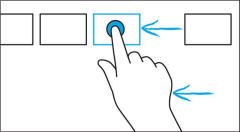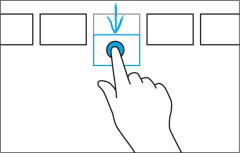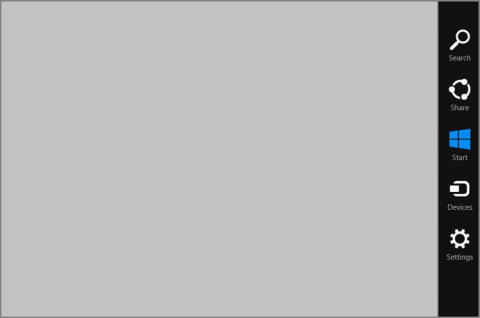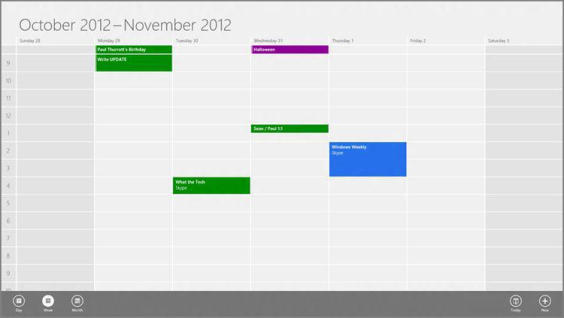What You Need to Know
We mentioned previously that we wrote this book for average users, and not technical experts. And that we assume you have used and understand modern Windows versions, especially Windows 7. And that your desire to learn more about Windows 8 has inspired this purchase. We won’t disappoint you.
The book doesn’t need to be read from cover to cover. That said, we do recommend reading through the first five chapters in sequence, if possible, since this is the foundation for understanding how the new operating system works and why things are the way they are. From that point on, feel free to cherry‑pick as needed, as you discover and wonder about specific new features.
But before diving into Windows 8, it’s important to understand a few basic concepts, especially if you’ll be utilizing this system on a new tablet computer or similar multi‑touch‑based device. Throughout this book, we make no assumptions about how you’ll interact with Windows 8, and we cover multi‑touch, mouse, and keyboard throughout, so no one gets left out. But multi‑touch‑based Windows machines, while not technically new, are going to become a lot more popular with Windows 8. And more important, perhaps, Microsoft has seriously bolstered multi‑touch support in Windows 8 so that it is now an incredible, integrated experience. And if you’re using a multi‑touch device of any kind, you’ll want to know a few basics.
So let’s start there.
Using Windows 8 with Multi‑Touch
Those with multi‑touch tablets and other touch‑based Windows devices will soon discover that Windows 8 works quite naturally, and much like other familiar touch devices such as Windows Phone, iPhone, or Android smartphones or the iPad and other tablets. But Windows 8 is far more sophisticated than these other products, so while the basics are the same, understanding a few key multi‑touch gestures and actions is key to getting off on the right foot, er, finger.
Here’s what you need to know.
• Tap: To open an item, simply tap it with your finger, as shown in Figure 1. This works identically to clicking the item with the mouse.
Figure 1: Tap an item to open it.

• Tap and hold: To get more information about an item, tap and hold on that item. (Microsoft calls this “press and hold” for some reason.) This works similarly to right‑clicking an item with a mouse, and the result is often similar, with a menu appearing providing more information or options. Tap and hold can be seen in Figure 2.
Figure 2: Tap and hold an item to view more information.

• Slide to drag: With some Windows 8 user experiences, you can tap and hold an item and then drag it to a new location on‑screen by swiping your finger slowly in whatever direction you wish to go. This action, which is commonly used for rearranging tiles on the new Windows 8 Start screen, can be seen in Figure 3 and is similar to using a mouse to drag an item around.
Figure 3: After tapping and holding, you can use a slide gesture to move an item.

• Pinch to zoom out, stretch to zoom in: Users of touch‑based smartphones and tablets are probably familiar with the pinch and stretch methods of zooming out and zooming in a display, respectively. You touch the screen with two fingers simultaneously and then move them away from each other to zoom in, as seen in Figure 4. Or, if you move the two fingers toward each other, you can zoom out. These actions are typically used in apps like Photos or Maps where zooming is a common activity.
Figure 4: Pinch or stretch with two fingers to zoom.

• Rotate: With this fairly uncommon gesture, you can rotate the display either clockwise or counterclockwise. To do so, touch the screen with two fingers simultaneously and then turn your hand in either direction, as in Figure 5. Few apps support this gesture.
Figure 5: Rotate the display with two fingers.

• Slide scrolling: While smartphones often use a vertical form of scrolling, similar to document‑based applications like Microsoft Word, Windows 8 was designed to be used in landscape mode by default, and its multiscreen experiences usually scroll from left‑to‑right, not up and down. To scroll quickly through these multiscreen experiences, you can swipe the display with your finger, as in Figure 6. A swipe to the left will cause the display to scroll to the right.
Figure 6: Scroll through a multiscreen display by swiping with your finger.

• Swipe selecting: To select an item in Windows 8, you can swipe on that item using a short downward gesture. When you do so, it will typically become visually highlighted in some way, indicating the selection, and additional options will appear, often in an app bar, which can be attached to the top or bottom edge of the screen. A swipe selection gesture can be seen in Figure 7.
Figure 7: A short downward swipe can select an item.

• Edge swiping: Windows 8 provides app‑specific and system‑wide capabilities via so‑called edge user interfaces, or edge UIs. To activate an edge UI, you swipe in toward the center of the screen from an edge. You swipe in from the top or bottom edge of the screen to display an app’s edge UI. And you can trigger various system‑level capabilities by swiping in from the left or right edge of the screen. (These actions are further discussed in Chapter 3.) You can see an example of edge swiping in Figure 8.
Figure 8: Activate edge UIs by swiping in from the edge of the screen.

• Swipe app closing: You can close any Metro‑style app by swiping down from near the top edge of the screen to the bottom of the screen, as in Figure 9. As you do, the app display will appear in a large thumbnail and that thumbnail will visually disappear as it is dragged to the bottom of the screen, and the app is closed.
Figure 9: Closing an app by swiping from the top of the screen.

Note that swiping down from past the top edge of the screen will trigger the app’s edge UI. To close the app, you must swipe down from near the top edge of the screen, but still on the app itself.
Using Windows 8 with a Mouse and Keyboard
If you’re using Windows 8 on a more traditional PC with a mouse and keyboard, things work largely as before and even when you’re interacting with the Metro‑style experiences and apps, you’ll discover that all of your previous PC experiences are relevant. There are two things you should know about, however.
First, Windows 8 introduces a wide range of new keyboard shortcuts, many of which utilize the Windows key that is now common on all PC keyboards. We discuss these shortcuts throughout the book as the need arises, but you can reference the appendix for a complete rundown of Windows Key keyboard shortcuts.
Second, Windows 8 provides support for the edge UIs mentioned previously to mouse users via new “hot corners” on the screen. Since these interfaces are so central to using Windows 8 effectively, we discuss them fairly extensively in Chapter 3 and then again in Chapter 4. But a quick overview is provided here.
• Start: Microsoft has removed the Start button in Windows 8 so that it can provide a more consistent Start experience that works with both the Metro and desktop environments. To toggle Start, you can tap the Start key on your keyboard, press the Windows key button on your Windows device, or mouse the mouse cursor into the lower‑left corner of the screen. (Yes, this is one of those “hot corners” we just mentioned.) When you do so, the Start tip thumbnail, shown in Figure 10, appears. (Or, if you’re already on the Start screen, a tip for the previous experience appears.) Click this to return to the Start screen (or previous experience.)
Figure 10: It’s no button, but the Start tip works somewhat similarly to the old Start button.

• Back and Switcher: To access the previous experience, move the mouse cursor into the upper‑left corner of the screen. A thumbnail of the previously used Metro app or other experience will appear, as in Figure 11. Click this to use that app. Or, move the mouse cursor down the left edge of the screen to display the new Switcher interface that lets you switch to any previously used app.
Figure 11: The Back tip

• Charms: If you move the mouse cursor into the upper‑right or lower‑right corner of the screen, you can display the new Charms bar, a set of system‑level commands and capabilities. The Charms are shown in Figure 12.
• App commands: When you’re using a new Metro‑style app, you can display its app bar by right‑clicking any empty spot on‑screen. An app bar is shown in Figure 13.
OK, that’s enough to get you started. Again, we cover these and other interactions you’ll want to know throughout the book as needed.
Figure 12: The Charms bar can be accessed via hot corners on the right side of the screen.

Figure 13: Metro‑style apps offer more commands on hidden app bars.

Дата добавления: 2015-05-13; просмотров: 851;
